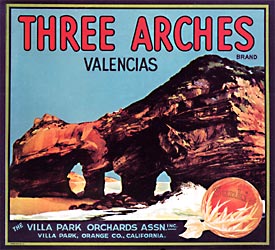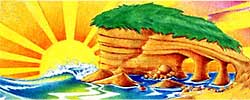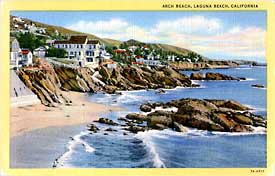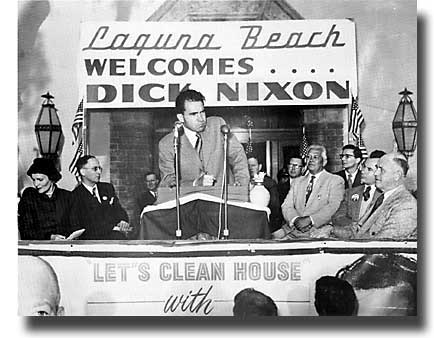A Short History of Laguna BeachBy Karen Turnbull (My lovely wife)
Steep cliffs, water-etched coves, rolling hills, and deep canyons surround a small, flat basin where vacationers used to come in the summer to escape the inland heat. Eventually a little village grew up along the sea with year-round residents. Laguna Beach and her adjoining community, South Laguna, are unique in Orange County for their dramatic topography. This includes steep coastal mountains that plunge into the sea and over thirty individual coves and beaches along an eight-and-a-half mile stretch from Three Arch Bay on the south to Crystal Cove on the North.

Although North Laguna was a part of the San Joaquin Rancho, downtown Laguna and South Laguna were never part of a Spanish or Mexican land grant but remained government land available for homesteading. Through the Timber-Culture Act of 1871, migration to the Golden West was encouraged. Families began to arrive and stake out their 160-acre claims and plant the required ten acres of trees - in Laguna's case always the Australian eucalyptus. The groves planted in the 1880's helped form the character of Laguna and added much-needed shade, although as lumber they were virtually useless. The groves grew so prodigiously that in the 1910's, trees had to be cut down by the dozen to carve out space for the growing community.

In 1871, Eugene Salter, the first American settler of South Laguna, claimed part of Aliso Canyon. He soon moved away and his 152 acres and one-room shack were claimed by George and Sarah Thurston. They came from Utah with six of their eventual thirteen children. Their three-year old girl was stolen by Indians on the journey and was never found. Their son, Joseph Thurston, chronicled the family's life and times in "Laguna Beach of Early Days" (1947). George Thurston raised vegetables and melons and sold them in Los Angeles, which was then a five day trip by wagon. The family name is remembered in Thurston Intermediate School, Thurston St., and Sarah Thurston Park in Laguna Canyon

During the southern California real estate boom of the 1880s Arch Beach was a separate community. It was granted a post office in 1889, two years before Laguna had one. From May 15, 1891, to September 17, 1904, Laguna Beach was called "Lagona," a corruption of the Spanish word for lagoon. The first postmasters were Hub Goff at Arch Beach and Joseph Yoch in Laguna South Laguna, under the name "Three Arches", had Mrs. Grace Powers as postmistress. The following year, residents voted for a new name. "South Laguna" was not one of the choices on the ballot, but it won by a write-in vote. In 1878, John Damron acquired 528 acres near the mouth of Laguna Canyon, including Temple Hills and the "flats" above Arch Beach. The property was later purchased by George Rogers for $1,000 and was subdivided into lots. The Rogers home stood on the site of the present city hall. Rogers and his daughter Elizabeth are credited with planting the huge pepper tree that stands in front of city hall. Rogers built a one-room school adjacent to his home for his eight children and hired a teacher. Several other children attended as well, marking this as Laguna's first real attempt at public education. This building later became the home of the Old Joe Lucas, the Portuguese fisherman who spoke English only while swearing. He was Laguna's first "Greeter", the predecessor of the famous greeter Eiler Larson, who waved to motorists on the highway from the 1940's through the 1960's.
The next school was built in Laguna Canyon by the Mormons who settled near the intersection of El Toro Road and Laguna Canyon Road. The school was built in 1888 for twenty children with their teacher, Mr. W.S. Brown. In 1893, this building was moved to the Canyon Acres area, then to Legion and Through streets where it became a church and later the art studio of Joseph Kleitsch. Building materials did not grow on trees (at least not on eucalyptus tress), and most buildings were recycled in the early days.
The third school was built on Park Ave. in 1908 on the site of the old cemetery. This two-room school was soon outgrown and was moved down the hill to its present location where it is used as the Legion Hall. When grading the road for the next school in 1928, the bones of Capt. Oliver Brooks were accidentally exhumed and were moved to a cemetery in Santa Ana. There are an estimated dozen burials still underneath the present high school, which was finally constructed in 1935. Prior to that time, students were bused to Tustin High.
Always a tourist town, Laguna Beach opened its second hotel in 1889. It was built by Henry Goff and purchased by Joseph Yoch for $600. Yoch also bought the defunct Arch Beach Hotel. He had it cut into three sections, moved it into town, and joined it to his hotel, creating a massive establishment of thirty bedrooms and two bathrooms. This hotel was condemned in 1928, and the present Hotel Laguna opened the following year on the same site. The next vacation retreat was the Brooks House, built in 1892. It was a red, two-story Victorian structure located on the present site of the Isch Building. Unfortunately, the hotel burned down before the paint was completely dry.
In South Laguna, the Egans, Shrewsburys, Andersons, and Goffs were homesteaders raising beans and melons. South Laguna had several close calls with commercialism. In 1889, the Santa Fe Railroad purchased Goff Island (now Treasure Island) and planned a depot and resort. When the tracks were laid inland instead, those plans failed. The depression of the 1890's saved South Laguna from an urbanized future.
Other early residents included Oscar Warling and Fred Trefren who operated a stage line to El Toro and Santa Ana which ran daily from 1884 to 1901. John Nicholas Isch ran the livery stable (on the site of the present Isch Building). He also ran a grocery and was one of the early postmasters. Known for his trusting ways, he never locked up when he went fishing. Customers came in to shop and to pick up their own mail. They could pay the next time they came in. For a number of years, the only telephone in a town was in the store. The phone was connected with the Irvine ranch house, and messages could be relayed from there to the outside world.

North Laguna, called Laguna Cliffs, was developed by Howard Heiseler, L.C. McKnight, and the Thumb Brothers. In 1905, they subdivided and laid out the only streets in Laguna that run at straight angles to one another. Water was piped in from Laguna Canyon, and this was the first neighborhood offering water with every lot. Wells had been used for years and water was hauled in barrels from Laguna or Aliso canyons into town. It had been said "Laguna was long on scenery and short on improvements, especially drinking water." The first important artists to arrive was Norman St. Clair. Who took the train from Los Angeles and the stagecoach from El Toro. He made lots of sketches of the area. He exhibited throughout California, attracted other artists, and a tradition was born.

As news of the picturesque village spread, the artists came in droves. They included Frank Cuprien, Gardner Symonds, William Wendt, William Daniell, Anna Hills, and William Alexander Griffith. Some artists banded together in 1913 and rented a small wooden building that had been a church, dance hall and meeting place. Under the leadership of Edgar A. Payne (who painted the mural in the movie theater), the artists refurbished the building and held their first exhibition in August, 1918. Three hundred people attended the first day and 2000 the first month. They seemed to be onto something big. This showing was the beginning of the Laguna Beach Art Association and the Museum of Art. Today Laguna continues to be an artistic focal point of Orange County - a major center for arts and crafts.

Laguna Beach is also home to the internationally known Festival of the Arts - Pageant of the Masters. The first pageant ever held in Laguna was an Indian pageant promoted by Isaac Frazee. It was called Kitshi Manido and was held in the large eucalyptus grove at sleepy Hollow (corner of Catalina and Arroyo Chico streets). The second Kitshi was held in 1927 in Laguna Canyon on the Boys Club property. In 1932, Roy M. Ropp conceived of the idea of a pageant and art festival. El Paseo (a little street by Hotel Laguna) was used as the site. Booths were set up and a stage was built on which people posed against painted backdrops to recreate great works of art. Eventually, James Irvine donated a small canyon for the pageant, and on the tenth anniversary of the festival, Irvine Bowl was dedicated.

Laguna's "village" character still remains in spite of growth and commercialism. No small part of this charm is due to the shaggy eucalyptus and one-of-a-kind architecture. Also, the relative isolation in which Laguna exists, surrounded by mountains, ocean, and greenbelts, keep the town a little different from neighboring cities. This geography makes it unlikely that Laguna will ever be absorbed into a major urban continuum. Concerned citizens work hard to acquire land just to leave it alone. Other groups work hard to promote laws permitting little change. The artistic spirit prevails, and it seems likely that Laguna's charm will be here for a long time to come. - Karen Turnbull 1988
NOTE: See the amazing and very rare historic photos of South Laguna Beach from the personal photo collection of Howard Wilson, the authors father. - A fantastic look back for those who wonder what it was like before civilization hit!
|
|||
|





 Elmer
Jahraus came to Laguna from Santa Ana in 1903 and soon opened a cigar
factory in the lower floor of the Yoch Hotel. In 1913, he opened Laguna
Lumber which is significant in that this enabled the community to grow
at unprecedented rates. Prior to the lumberyard, construction materials
were hauled by mule down Laguna Canyon, or were floated in on the tide
from boats, usually the schooner Emma.
Elmer
Jahraus came to Laguna from Santa Ana in 1903 and soon opened a cigar
factory in the lower floor of the Yoch Hotel. In 1913, he opened Laguna
Lumber which is significant in that this enabled the community to grow
at unprecedented rates. Prior to the lumberyard, construction materials
were hauled by mule down Laguna Canyon, or were floated in on the tide
from boats, usually the schooner Emma. 